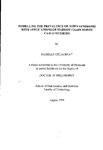MODELLING THE PREVALENCE OF DOWN SYNDROME WITH APPLICATIONS OF MARKOV CHAIN MONTE CARLO METHODS
| dc.contributor.author | BRAY, ISABELLE CELlA | |
| dc.contributor.other | School of Engineering, Computing and Mathematics | en_US |
| dc.date.accessioned | 2013-10-28T11:12:15Z | |
| dc.date.available | 2013-10-28T11:12:15Z | |
| dc.date.issued | 1998 | |
| dc.identifier | NOT AVAILABLE | en_US |
| dc.identifier.uri | http://hdl.handle.net/10026.1/2408 | |
| dc.description.abstract |
This thesis was motivated by applications in the epidemiology of Down syndrome and prenatal screening for Down syndrome. Methodological problems arising in these applications include under-ascertainment of cases in livebirth studies, double-sampled data with missing observations and coarsening of data. These issues are considered from a classical perspective using maximum likelihood and from a Bayesian viewpoint employing Markov chain Monte Carlo (MCMC) techniques. Livebirth prevalence studies published in the literature used a variety of data collection methods and many are of uncertain completeness. In two of the nine studies an estimate of the level of under-reporting is available. We present a meta-analysis of these studies in which maternal age-related risks and the levels of under-ascertainment in individual studies are estimated simultaneously. A modified logistic model is used to describe the relationship between Down syndrome prevalence and maternal age. The model is then extended to include data from several studies of prevalence rates observed at times of chorionic villus sampling (CVS) and amniocentesis. New estimates for spontaneous loss rates between the times" of CVS, amniocentesis and live birth are presented. The classical analysis of live birth prevalence data is then compared with an MCMC analysis which allows prior information concerning ascertainment to be incorporated. This approach is particularly attractive since the double-sampled data structure includes missing observations. The MCMC algorithm, which uses single-component Metropolis-Hastings steps to simulate model parameters and missing data, is run under three alternative prior specifications. Several convergence diagnostics are also considered and compared. Finally, MCMC techniques are used to model the distribution of fetal nuchal translucency (NT), an ultrasound marker for Down syndrome. The data are a mixture of measurements rounded to whole millimetres and measurements more accurately recorded to one decimal place. An MCMC algorithm is applied to simulate the proportion of measurements rounded to whole millimetres and parameters to describe the distribution of NT in unaffected and Down syndrome pregnancies. Predictive probabilities of Down syndrome given NT and maternal age are then calculated. | en_US |
| dc.language.iso | en | en_US |
| dc.publisher | University of Plymouth | en_US |
| dc.title | MODELLING THE PREVALENCE OF DOWN SYNDROME WITH APPLICATIONS OF MARKOV CHAIN MONTE CARLO METHODS | en_US |
| dc.type | Thesis | |
| dc.identifier.doi | http://dx.doi.org/10.24382/3648 | |
| dc.identifier.doi | http://dx.doi.org/10.24382/3648 |
Files in this item
This item appears in the following Collection(s)
-
01 Research Theses Main Collection
Research Theses Main


